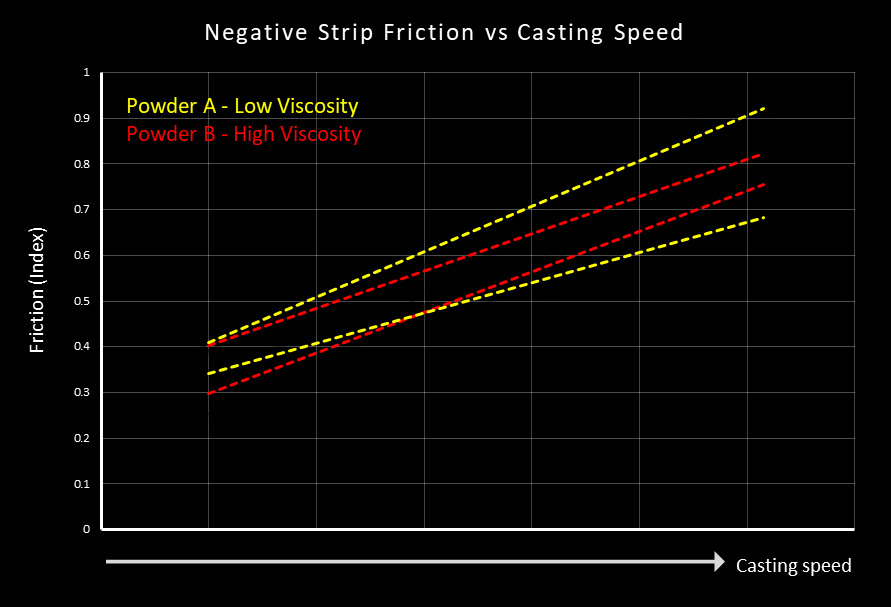In continuous casting of steel, improving product quality and preventing breakouts are essential to profitable production. Mold friction analysis is one measurement that can help steel casters better understand constant changes in the continuous casting machine and make adjustments that optimize steel output and quality.
If you’re new to mold friction or its analysis, this article was developed to define the term, explain how mold friction is calculated, and outline some of the key ways that analysis can help continuous casting machine operators optimize performance.
What is Mold Friction?
The friction between the casting strand and the oscillating mold is known as mold friction. Analyzing this friction data helps to optimize mold lubrication and other casting parameters, reducing the occurrence of surface defects and breakouts.
How is Mold Friction Calculated?
To calculate mold friction on a continuous casting machine, you must measure both the acceleration of the mold and the force required to oscillate the mold.
Measure Acceleration of the Mold
To measure mold acceleration, operators can use high-precision accelerometers which are mounted permanently on the mold oscillation system. When taking this measurement, it’s important to ensure you are measuring the actual movement of the mold table, rather than the theoretical movement indicated by the oscillation control system.
Measure the Force Required to Oscillate The Mold
Mold oscillation force can be derived in two ways:
- From the hydraulic pressure required to oscillate the mold
- Load pins or optical strain gauges can also be used if assessing an electro-mechanical system.
To calculate force, this data must first be gathered during a casting simulation. That data should then be compared to the data gathered during a real casting event. With data from both, you can calculate the additional force required to accelerate the mold during casting.
That additional force, combined with actual acceleration, gives the friction between the strand and the mold.
Analyzing Mold Friction: How Can it Optimize the Continuous Casting Process?
Mold friction can be affected by a variety of steel casting factors, from steel grade to lubrication types, casting speed, superheat, and more, which is why careful recording and monitoring of data is essential to accurately analyze and improve casting conditions. When monitored and analyzed properly, data can provide a wealth of insight, informing operators how best to optimize the continuous casting process. With better data, operators’ optimizations can ultimately lead to increased productivity and improved casting quality.
Optimizing Mold Flux using Mold Friction Data
One of the most critical aspects of continuous casting is the lubrication in the mold. For those casters using mold powder, the data provides a vital insight into the performance of the mold powder under different conditions.
Friction, together with heat removal data, can identify the best powders for particular steel grades, and the best conditions under which these powders should be used.

In this example, casting with low viscosity mold powder A gives a high variability of mold friction at higher casting speeds, indicating that the flux is “consumed” more quickly than the melting rate.
The product cast with powder A tended to have more longitudinal cracks at higher casting speed.
Conversely, the higher viscosity powder B shows less variability in friction at higher casting speed, indicating that the consumption of this flux is matched with the melting rate. Powder B produces significantly fewer longitudinal cracks.
By analyzing the mold friction for different powders under different casting conditions and for different grades, the process and the powder properties can be fine-tuned.
Monitoring Mold Friction in Real-Time: Maintain Optimal Continuous Casting Conditions
Understanding mold friction enables operators to fine-tune the casting process. When monitored in real-time, casting supervisors have a clear indication of the stability of current mold conditions and can make adjustments and modifications during casting to maintain optimal friction conditions between the mold and the strand.
For the operator ready to prevent breakouts and defects, rather than respond to them, mold friction systems can offer dynamic adjustments made by the system, not the operator. These systems continuously monitor, along with a range of other casting parameters, to help provide casting supervisors with the data they need to maintain optimal continuous casting conditions.
If you’re ready to implement high-level process and quality control in your continuous casting facility, the KT500F Mold Friction system offers the features you need. With real-time feedback of mold/strand friction measurements, along with a range of other measurements and variable analysis, this system can help provide a deeper layer of insight into casting stability. Get ahead of steel casting breakouts and defects. Talk to the Kiss Technologies team today.
